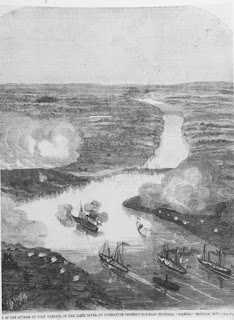Another thing I would do if I had it to do over again writing The Siege of Petersburg: The Battles for the Weldon Railroad, August 1864, is to illustrate the book more methodically--not just with more maps, but with more photos and drawings. As I illustrate The Petersburg Regiment, 12th Virginia Infantry, I've come across some helpful websites for illustrations. There is http://www.petersburgproject.org/, where I found the following drawing of the Gurley House from the Diary of Francis W. Knowles:
There is https://www.history.navy.mil/, where I found helpful pictures of ships and naval actions (the ship is USS Thomas Freeborn and the action is First Drewry's Bluff):
There are also websites for Harper's Weekly, Frank Leslie's Illustrated History of the Civil War, and Battles and Leaders of the Civil War. These are so easy to find that you just have to put those titles in your search engine to come up with the websites. The Library of Congress and the National Archives are also readily available, as is the U. S. Army Heritage and Education Center.
There is https://www.history.navy.mil/, where I found helpful pictures of ships and naval actions (the ship is USS Thomas Freeborn and the action is First Drewry's Bluff):
There are also websites for Harper's Weekly, Frank Leslie's Illustrated History of the Civil War, and Battles and Leaders of the Civil War. These are so easy to find that you just have to put those titles in your search engine to come up with the websites. The Library of Congress and the National Archives are also readily available, as is the U. S. Army Heritage and Education Center.


